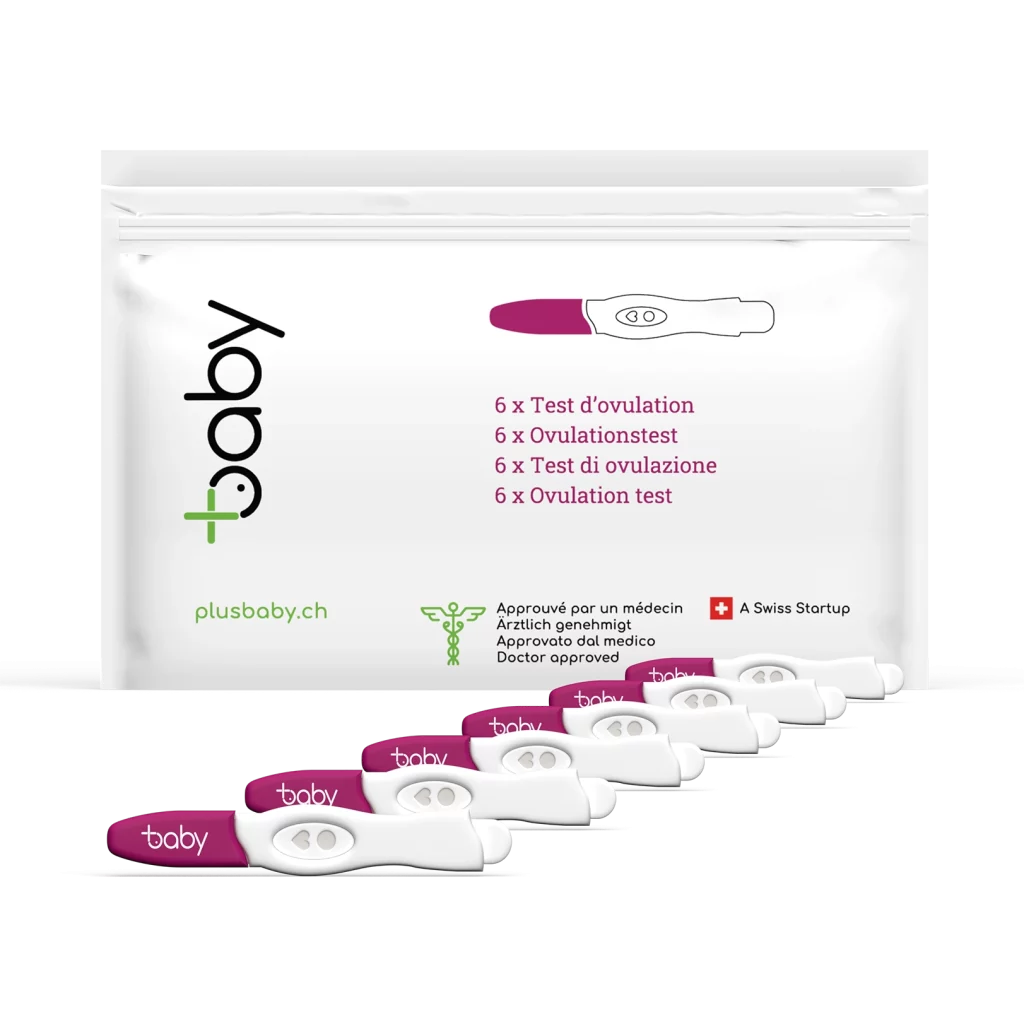3 for the price of 2! 🎁 Free delivery on all orders - Visit Our Shop!
Understanding the mysteries of the menstrual cycle and the subtleties of ovulation is essential for any woman or couple looking to conceive a child, plan their family or simply understand their body better. An invaluable tool in this journey of discovery, the ovulation test plays a crucial role in providing vital information about the most fertile period of the menstrual cycle. These tests, often using a simple urine sample, detect an increase in certain hormones, principally luteinizing hormone (LH), signalling the imminence of ovulation.
The menstrual cycle, with its different phases from follicular to luteal, is not only a witness to the body's preparation for a possible pregnancy, but also a key indicator of general health and female fertility. Each cycle offers a window of opportunity - the ovulation period - when the chances of fertilization are maximized. Understanding this period is crucial, whether for increasing the chances of conception or for contraceptive planning.
The egg released during ovulation only survives for a short time, while the sperm can remain viable for longer. Identifying the precise moment of ovulation therefore becomes a fundamental aspect for those wishing to conceive. Cervical mucus, which changes texture throughout the cycle, provides further clues as to the approach of this fertile phase. In addition, methods such as body temperature curve monitoring can complement the use of ovulation tests for a more accurate and thorough understanding of the most propitious period for conception.

The menstrual cycle is a complex and regular biological process, essential to female fertility. It begins on the first day of menstruation and ends the day before the next period begins. The average length of a cycle is 28 days, but it can vary significantly from one woman to another, from short cycles of 21 days to longer cycles of up to 35 days. Irregular cycles are not uncommon, especially in young girls after puberty and in women approaching menopause.
Ovulation is the key moment in the menstrual cycle, when a mature egg is released from the ovary. This release generally occurs around day 14 for an average 28-day cycle, but this date may vary according to the length and regularity of the individual cycle. The ovulation period is the window of fertility, when the chances of getting pregnant are highest. This fertile period generally spans six days, including the day of ovulation and the five days preceding it, due to the lifespan of spermatozoa in the female reproductive system.
Hormones play a crucial role in regulating the menstrual cycle and initiating ovulation. The menstrual cycle is orchestrated by a complex interaction between several hormones, mainly estrogen and progesterone, secreted by the ovaries, and follicle-stimulating hormone (FSH) and luteinizing hormone (LH), produced by the pituitary gland.
Ovulation tests, such as those from Plusbaby, detect luteinizing hormone (LH) in the urine. A spike in LH signals that ovulation is imminent, usually occurring within 24 to 36 hours. These tests are used to identify the most fertile days of the cycle, thus increasing the chances of conception. They are generally performed by collecting a urine sample and analyzing the presence of LH.
The best time in the menstrual cycle to use an ovulation test depends on the length of your cycle. Generally speaking, it's advisable to start testing a few days before the expected date of ovulation. For a 28-day cycle, this could be around day 11. For longer or shorter cycles, adjust accordingly. Ideally, you should test at the same time each day, and reduce fluid intake before testing to avoid diluting the urine sample.
Plusbaby has designed a packaging 6 ovulation tests to match the typical fertility window, which lasts around 6 days. This enables users to test every day during this crucial period, maximizing the chances of detecting the LH peak and accurately identifying the optimal time for conception. This approach reduces the anxiety associated with the timing of ovulation and offers a more reliable and convenient method for women seeking to conceive.
When using Plusbaby ovulation tests, it is important to compare the test strip with the reference strip on each test. When the test band appears darker than the reference band, this indicates a peak in luteinizing hormone (LH), meaning ovulation is highly likely within the next 24 to 36 hours. Tracking this process over several days enables you to accurately determine the best time to conceive.
The best time of day to use an ovulation test is usually in the morning, when the concentration of luteinizing hormone (LH) in the urine is highest. However, it is possible to do the test at any time of day, but it is advisable to avoid doing it immediately after getting up (do not use the first morning urine) or after drinking a lot of fluids, as this can dilute the urine and affect the accuracy of the test. The important thing is to use it every day, at the same time, to ensure a consistent result.

There are various types of ovulation test, including strips and digital tests. Strips are immersed in a urine sample and indicate the presence of LH by a color change. Digital tests, often much more expensive, provide a clear numerical or visual result. They are as effective as strip tests.
Plusbaby's tests offer accuracy better than 99%, guaranteeing reliable detection of peak LH and helping to determine the optimum time to conceive - all at a reasonable price.

Determining the fertile period is crucial for conception planning. Ovulation tests play an essential role in this process. By detecting the peak of luteinizing hormone (LH), these tests help identify the most fertile days of the menstrual cycle. Women can use these tests a few days before the expected ovulation date to track the increase in LH, indicating the optimal period for fertilization.
Cervical mucus, a secretion produced by the cervix, changes texture during the menstrual cycle, becoming clearer, more elastic and abundant during the fertile period. Observing these changes can provide additional clues about the approach of ovulation. The consistency of the mucus during this period facilitates the movement of sperm towards the egg, thus increasing the chances of conception.
By combining ovulation tests and cervical mucus observation, women can gain a thorough understanding of their fertile period, maximizing their chances of getting pregnant.
Fertility, a complex and multifactorial journey, is influenced by a variety of biological and environmental elements. Understanding the key factors that affect fertility is essential for anyone seeking to conceive. This section focuses on three crucial aspects: sperm quality and characteristics, egg viability, and uterine condition. Each of these elements plays a significant role in the ability to conceive and maintain a healthy pregnancy.
The role of sperm
Ovum quality
Uterine conditions
Optimizing design opportunities
Achieving conception is a goal for many couples, but it can sometimes be a challenge. Optimizing the chances of pregnancy requires a thorough understanding of fertility and a proactive approach. We'll explore methods for targeting the fertile period, adopting a healthy lifestyle, and understanding the importance of medical consultation, all with the aim of improving the chances of success in the quest for parenthood.
In addition to ovulation tests, there are other effective methods for monitoring and understanding fertility. The basal body temperature curve, for example, is a technique that involves taking a daily body temperature reading on waking. A slight rise in temperature generally indicates ovulation. Interpreting these variations helps identify the fertile period of the cycle. In addition, the use of calendars and menstrual cycle tracking apps is becoming increasingly popular. These digital tools can track menstrual cycles, predict ovulation, and even flag up potential abnormalities, offering a personalized overview of fertility. These methods, combined with a thorough understanding of the menstrual cycle, can greatly assist women in their fertility journey.
Using basal body temperature to monitor fertility involves taking a daily body temperature upon waking, before any physical activity. This temperature is generally lower before ovulation and rises slightly (about 0.5°F or 0.3°C) after ovulation due to progesterone production. By recording these measurements day after day, a woman can identify a pattern indicating her ovulation. This method requires regularity and precision to be effective, and can be particularly useful for women with irregular cycles.
An ovulation test is generally considered more accurate than the basal body temperature method for identifying the fertile period. Ovulation tests directly detect the peak of luteinizing hormone (LH) in the urine, which occurs just before ovulation. This hormonal detection is more direct and less subject to variation than basal body temperature measurement, which can be influenced by many factors such as sleep, illness or stress. So, for greater precision in determining the fertile period, ovulation tests are often preferred.
The use of fertility calendars and apps involves regularly recording information about the menstrual cycle, such as the duration of periods and symptoms associated with ovulation. These tools calculate and predict ovulation days and the fertile period based on the data entered. They offer a personalized overview of the menstrual cycle and can even help identify irregularities or trends. However, their accuracy depends on the regularity of the user's cycle and the consistency of the data entered. These applications are particularly useful for women seeking to understand their cycle and plan a pregnancy.
On the other hand, an ovulation test is generally more accurate than using a calendar to identify the fertile period. Ovulation tests directly measure the peak of luteinizing hormone (LH), a reliable indicator of imminent ovulation. In contrast, calendars and apps rely on historical data and averages to predict ovulation, which can be less accurate, especially for women with irregular cycles. Tests therefore offer a more direct and reliable approach to determining the most fertile days.
In reproductive health, the impact of contraception is significant. The contraceptive pill and other contraceptive methods can affect the menstrual cycle and fertility, often by suppressing ovulation. This can lead to changes in the cycle, such as irregular periods or no periods at all. Once contraception has been discontinued, there may be a delay before fertility returns to normal. On the other hand, fertility problems such as infertility, irregular cycles or endometriosis are common concerns. Infertility can result from multiple factors, including hormonal disorders or anatomical abnormalities, while endometriosis can affect the ability of the egg to be fertilized or the embryo to implant. These problems often require specialized medical evaluation and treatment.
The contraceptive pill and other hormonal contraceptive methods act primarily by suppressing ovulation, thereby altering the natural menstrual cycle. They can also affect the thickness of the uterine lining and cervical mucus, reducing the likelihood of fertilization and implantation. After stopping these contraceptive methods, there may be a variable delay before the menstrual cycle and fertility return to normal. However, the long-term effect of these contraceptives on fertility is generally minimal, and most women return to their previous level of fertility after stopping contraception.
Fertility problems, such as infertilitythe irregular cyclesand, endometriosisInfertility is a significant reproductive health concern. Infertility can be due to a variety of causes, including hormonal, anatomical or lifestyle problems. Irregular cycles can complicate the prediction of the fertile period, making conception more difficult. Endometriosis, characterized by the growth of uterine tissue outside the uterus, can affect fertility by causing pain, inflammation and complications in the reproductive organs. These conditions may require specialized medical assessment and treatment to aid conception.
Understanding the menstrual cycle and using ovulation tests, like those offered by Plusbaby, play a crucial role in family planning and fertility management. These tests offer a precise approach to identifying the most fertile period, thus facilitating the conception process. The importance of these tools lies in their ability to provide reliable, personalized information, helping couples in their quest for pregnancy.






Stay connected with Plusbaby. Sign up for a free e-book to understand your menstrual cycle and help you identify your most fertile period. You'll also get early access to offers.



